Korea Aerospace and Defense Exhibition 2005 (Seoul Air Show 2005) Part 1
By Jay Kim
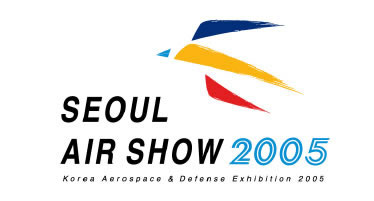
Korea Aerospace and defense exhibition 2005 was held at Seoul Airport in Seoungnam area located south of Seoul between Oct. 18 and Oct. 23. Alternatively known as Seoul Air Show, this premier international aerospace exhibition and air show in Korea was first held in 1996. The exhibition has grown into a large biennial aerospace fair attracting 225 companies from 24 countries worldwide this year. My last visit was in 2001 and show was beyond my expectations. After travelling 2 1/2 hours by subway and in taxi, I barely managed to arrive just before closing on last day and missed afternoon flight demo of world's best fighters. In last phase of F-X competition to select future multi-role fighter for ROKAF, Boeing, Dassault, Eurofighter and Sukhoi dominated 2001 exhibition. I was surprised at stunning scale mock-ups of F-15K, Rafale, Typhoon and Su-35 in exhibition halls. Tons of posters, brochures and booklets promoting their fighters and companies were available for tens of thousands of public visitors. Out of exhibition hall, I was lucky to see full-scale Typhoon and Su-35 displayed on dark runway. At the other end of runway, Dassault Rafale just took off and soared into dark evening sky and Su-35 was getting towed into runway to depart from Korea, leaving dozens of air force mechanics and viewers behind. Rafale's two SNECMA turbofans made deafening roar over runway and whole airfield rumbled along for another 5 minutes. Way cool! That was what I love.
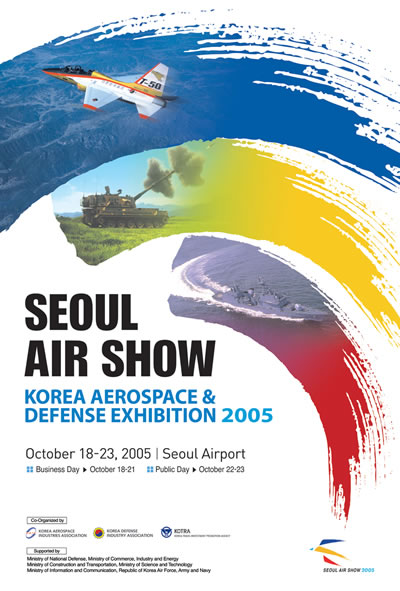
In 2002, our government and air force finalized Boeing F-15K as winner of F-X program and contracted with Boeing for 40 F-15Ks. Two F-15Ks from first production batch flew into Korea in time for the opening and made public debut during Seoul Air Show 2005. Rollout of two gunship grey F-15Ks were made in static display area on main runway. After taking off from Boeing facilities in St. Louis, two F-15Ks in serial number 003 and 004 flew across the Pacific via Hawaii and Island of Guam and landed at Seoul Airport 10 days before opening of Seoul Air Show. 6 refuellings were made by a USAF KC-10 during over 20 hours of flight. Basically advanced version of F-15E, ROKAF F-15K has up-to-date APG-63(V)1 radar, 3rd generation FLIR, helmet-mounted cueing system and can be armed with JDAM, SLAM-ER, AMRAAM and AIM-9X Sidewinder. New F-15Ks fully complement KF-16C, F-16C and F-4E frontline fighters in ROKAF with superior multirole capability, heavy payload and long combat radius. Next big focus of show were brand new T-50 advanced supersonic trainer and KT-1 basic trainer from domestic aerospace manufacturer Korea Aerospace Industries(KAI). Highly polished T-50 and KT-1 in exhibition hall quickly caught my eyes under dazzling spotlights. There was something I could not feel at the sight of brand new aircraft of foreign origin. T-50 advanced trainer and lead-in-fighter has been developed by KAI and Lockheed Martin and undisclosed number of T-50s are operational in ROKAF with fleet of T-38 and T-59(BAe Hawks) jet trainers. Featuring digital fly-by-wire for precision maneuver, variable camber wing with strakes, HUD, MFD cockpit, HOTAS and maximum speed of Mach 1.4, T-50 prepares future pilots for rapid transfer to current and next generation fighters like advanced F-16, F-22, F-35, Typhoon or Rafale. As current jet trainers from 50's and 60's are approaching limit of service life, KAI and Lockheed Martin expect robust sales in advanced trainer market worldwide. Aermach M-346 and Yak-130 are its rivals. KT-1 turboprop basic trainer will replace aging ROKAF T-37s and T-41s. KO-1 is observation and forward airborne controller based on KT-1 to replace Cessna O-2A in near future. Indonesia imported KT-1s for Indonesian AF.M
Around KAI's big booth in exhibition hall A, Samsung Techwin's huge K-9 Thunder self-propelled gun, K-10 AARV (Armored Ammunition Resupply Vehicle) modified from K-9 and Rotem (a Hyundai company) Scorpion, Jupiter AFVs were shown. In foreign exhibitors' area, E-X program to secure airborn early warning and surveillance aircraft for ROKAF draw a lot of attention from public. Last two contenders are Boeing and IAI-Elta. Boeing proposed E-737 with Northrop Grumman Mesa radar as in RAAF E-737 and IAI-Elta came up with smaller and less costly AEW & C solution combining Gulfstream airframe and Elta Phalcon radar. L3 Com withdrew its Airbus 321 based system from E-X competition early this year and proposed communications suite and data links for IAI-Elta project as new partner. The big ticket procurement would cost 1.9 billion dollars for 4 AEW & C aircraft. RAAF E-737 was supposed to be displayed on runway during exhibition. What I could see was a glimpse of distant Aussie E-737 on second day of my visit. Public access was not allowed but shape of Mesa radar on its body was clear to my eyes from a long distance. IAI displayed IAI-Elta G-550 scale mock-up in solid grey at indoor booth. Among hundreds of foreign exhibitors, Airbus with 1:1 A380 passenger cabin mock-up was most popular. Double-deck cabin was open to public. Many people walked into cabin to look around and tried passenger seats on 1st and 2nd floor. Surrounded by ergonomically designed interiors, brand new seats were neatly arranged and each passenger could secure enough legroom. USAF had its own booth down the hall. A few USAF officers were having fun flying virtual UAV mission on computers. In last hall E, US Embassy AES (Aerospace Executive Service) and AMCHAM (American Chamber of Commerce) in Korea offered a resting area with small bar for foreign staff and businessmen to relax in cozy corner. Lockheed Martin F-35 full-scale mock-up on runway was most popular US aircraft during exhibition. Many foreigners and local public gathered around the whole next generation fighter and climbed ladder to look inside the cockpit.
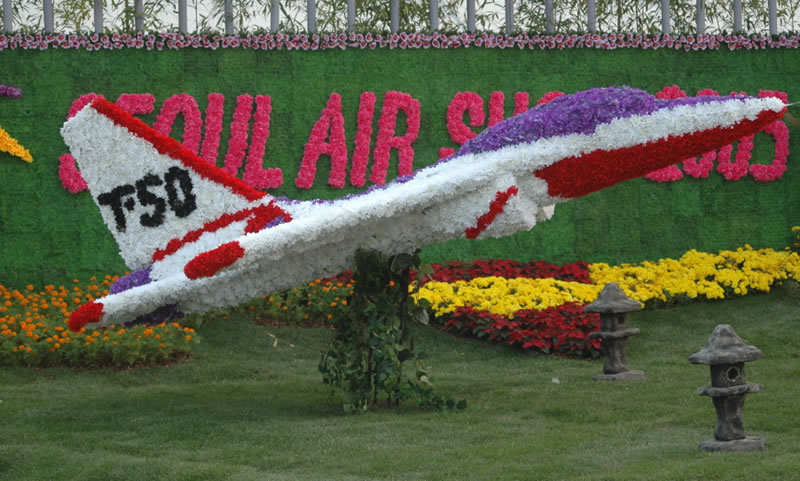
Commemorative flower garden at entrance. Note sweet-looking T-50 made of flowers instead of styrene!
I was on the venue on Oct. 20 and 21 but I did not see much of daily flights due to bad weather and inconsistent flight schedule. While taking pictures of aircraft on main runway on first day, I found an Su-31 running engine at full throttle to take off from a faraway runway. Su-31 was quick in the air and showed us spectacular aerobatic for 15 minutes. Aerobatic was sponsored by Lithuanian AF to celebrate Seoul Air Show 2005 and pilot was FAI World Grand Prix champion Jurgis Kairys, a famed professional aerobatic pilot and test pilot of Sukhoi Design Bureau who designed Su-26, 29, 31 aerobatic planes. Flights of KT-1, T-50, F-15C, B-1B and U-2 were scheduled but there was nothing other than Su-31 aerobatic on Oct. 20. Unfortunately it rained hard next day and absolutely all aircraft were grounded. Out of over a hundred pictures I had taken only two dozens looked good but local aerospace and defense sources came to the rescue with brilliant pictures. Korea Aerospace Industries(KAI), Monthly Aerospace Korea and two local webzines kindly allowed me to use very nice pictures of ROKAF Black Eagles aerobatic team, Jurgis' Su-31 and other aircraft that highlighted Korea Aerospace and Defense Exhibition 2005.
Many pictures I obtained for this article are by the courtesy of Korea Aerospace Industries (KAI), Monthly Aerospace Korea, bemil.chosun.com, Defence Korea
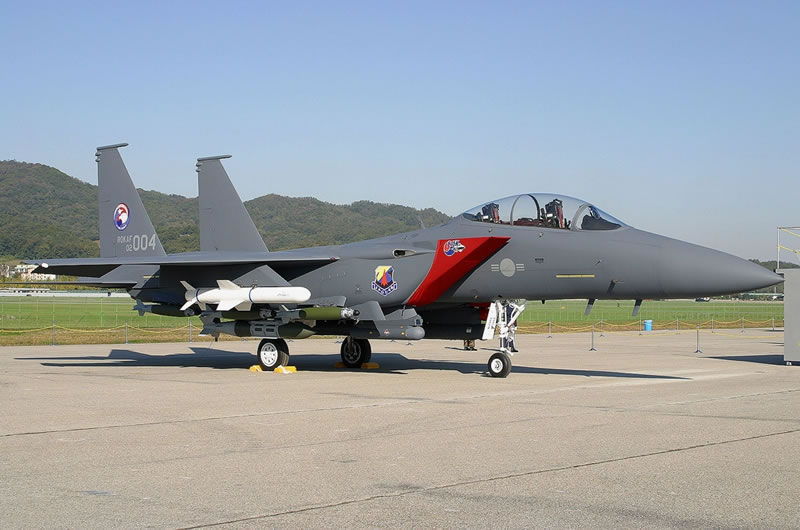
One of first two F-15Ks in serial number 004 on runway. Courtesy by bemil.chosun.com
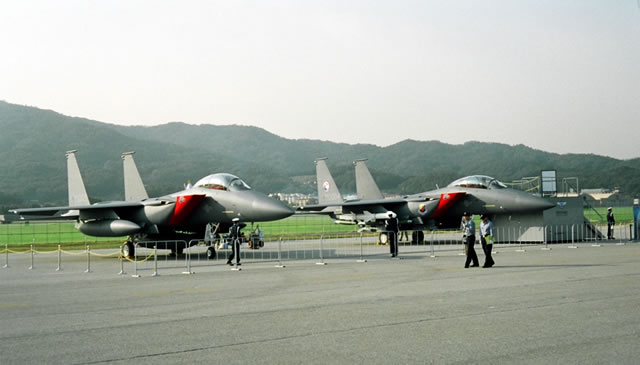
ROKAF F-15K 003 and 004 displayed on runway at Seoul Air Show 2005. F-15K was no.1 public attraction.
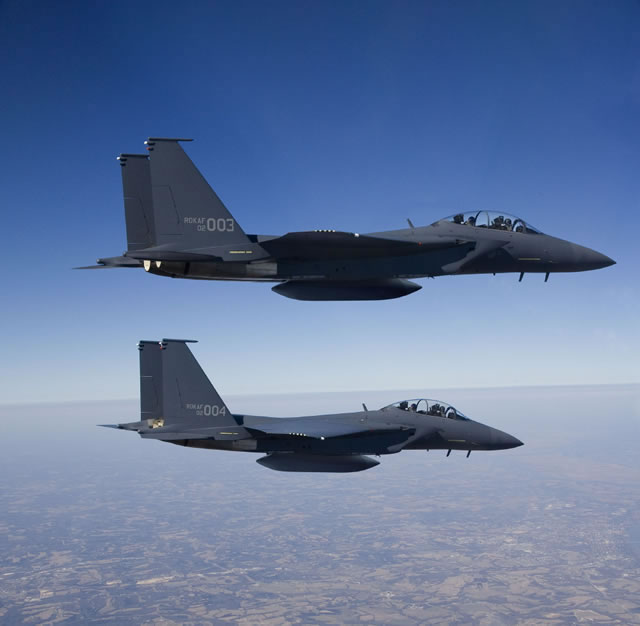
Flight of two F-15Ks en route to South Korea. Note serial number 003 and 004 on tails. Courtesy of bemil.chosun.com

First two ROKAF F-15Ks flew over the Pacific en route to South Korea. Courtesy by bemil.chosun.com
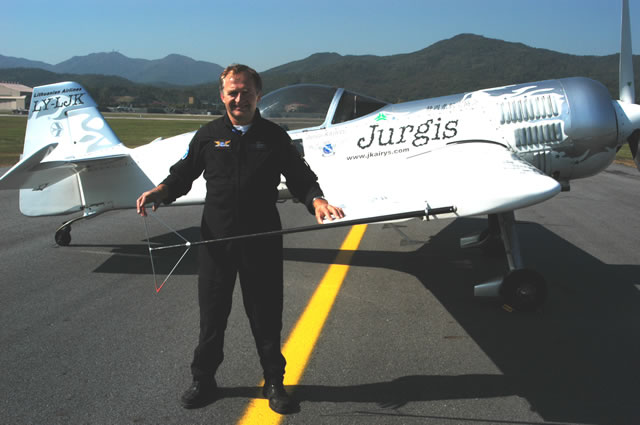
World aerobatic champion Jurgis Kairys with his beautiful Su-31. Courtesy by Monthly Aerospace Korea.
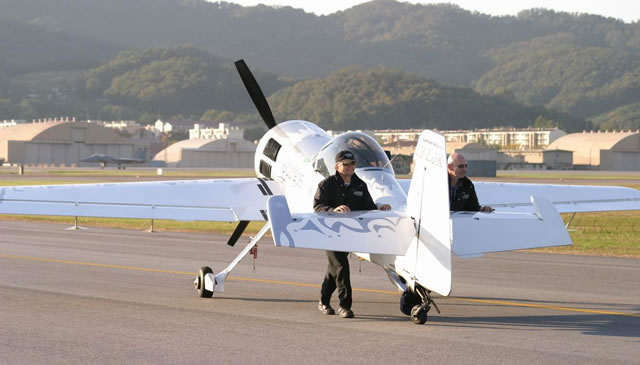
Pushing Su-31 on runway. Jurgis Su-31 stood out in beautiful sliver and white scheme unique to him. Courtesy by Monthly Aerospace Korea.
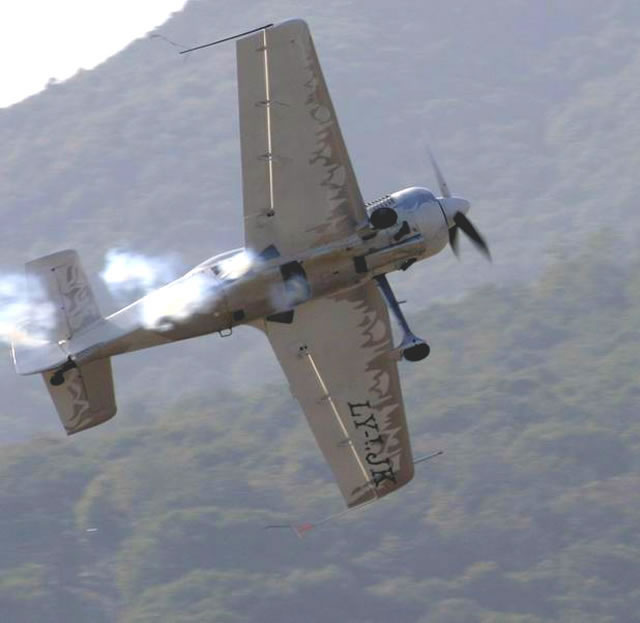
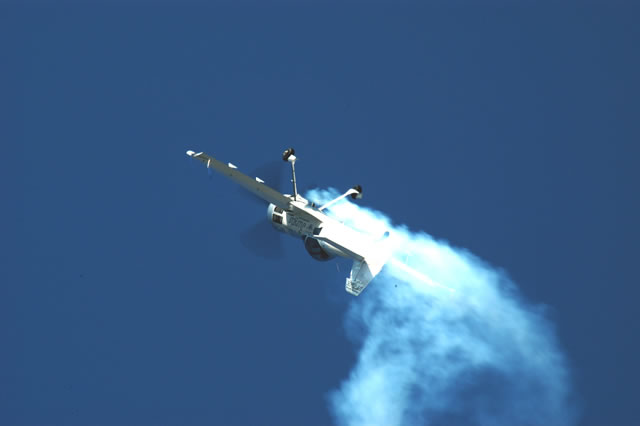
Spectacular aerobatic of Jurgis Su-31. Courtesy by Monthly Aerospace Korea
© Jay Kim 2006
This article was published on Wednesday, July 20 2011; Last modified on Saturday, May 14 2016
